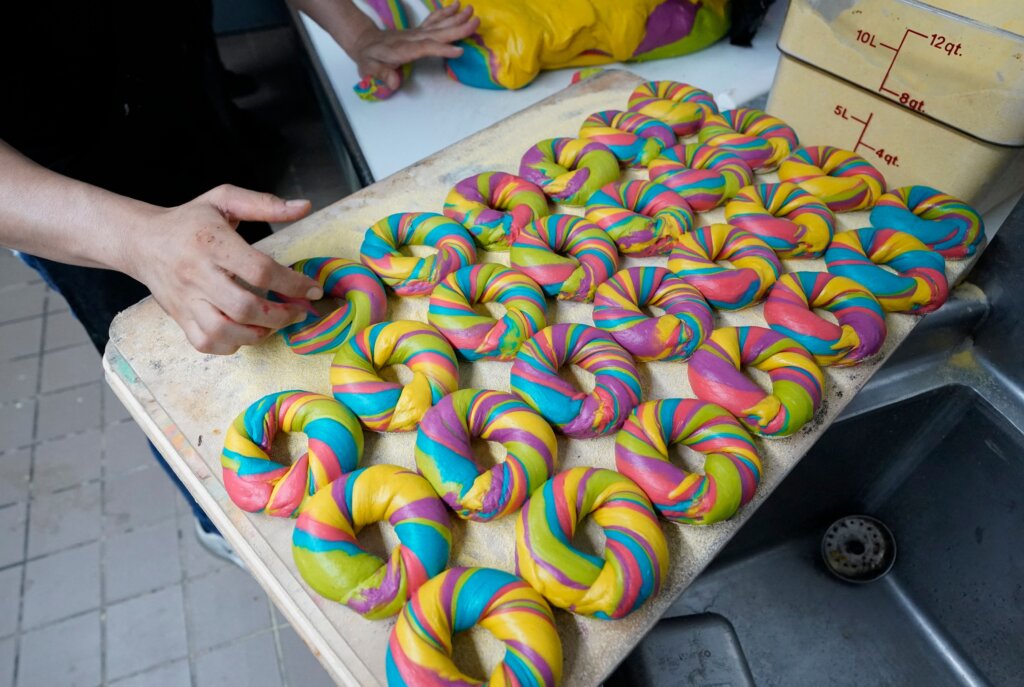Ripped, dipped, sliced and shmeared — what makes a bagel a bagel?
Rippable bagels are the newest controversy in the world of bagels, but far from the first

PopUp bagels, served ready for dipping, at an event. Courtesy of Getty Images
When you picture a bagel, perhaps you imagine the classic everything bagel slathered with shmear, capers and lox. Or maybe your ideal bagel is sesame with avocado and red onion, or a poppy seed base for an egg-and-cheese sandwich.
What you probably don’t envision is obliterating the bagel’s iconic circular shape by ripping it into hunks to dunk in a tub of cream cheese. But several hyped bagel bakeries are hawking exactly that: “rip and dip” bagels.
Calic Bagel in Los Angeles serves a stuffed bagel, and others pre-cut into wedge-like sections with cream cheese piped in between the gaps to save you the trouble of ripping or dipping; if you buy an uncut bagel, they’re clear that you should rip, not slice, the bread, a style of consumption they refer to as “LA bagel culture” on their website. (Fellow LA bakery Wake and Late also serves a rippable bagel.)
Perhaps this kind of innovation — “hacking” the bagel, if you will — should be expected of the tech-dominated West Coast, where bagels also have a less-entrenched history. But the ripping fad has also earned devotees in the homeland of bagels, New York City.
PopUp bagels, which began as a Connecticut backyard endeavor before opening several locations in the city and beyond, also serves a rip-and-dip bagel with an array of cream cheese flavors. They even trademarked the phrase “grip, rip and dip.”
It’s one thing to try to change up a classic by offering or even encouraging a new form of consumption. But at many of these bagelries, sandwiches are not even offered. Slicing is verboten. That means no lox, no capers, none of the Jewish heritage in food form that you can pile on a classic bagel.
There are, arguably, good reasons to avoid slicing your bagels. If you run a high-volume place with lines around the block — like the trendy Apollo Bagels, which is currently embroiled in a dispute with its landlord over its crowds — not slicing the bagels or making sandwiches helps keep things moving. (Though Apollo does offer basic sandwiches; maybe they should stop.)
And some, including PopUp’s owner Adam Goldberg, believe ripping is actually a paean to purity. “We are just purely bagel people,” he told AM NY. (Rebelle Bagels, a Boston-area shop that does offer bagel sandwiches, still posted on its Instagram that “slicing ruins the crumb,” though I imagine ripping or even biting would have a similar effect.)
To some bagel purists, however, rippable bagels are blasphemous. It’s not just about the loss of lox; the rippable bagels have to be a different texture to allow for tearing. The bagels are often lighter, even fluffy, instead of chewy and dense. The New York Times described PopUp’s bagel as “like a baguette.” In a Substack newsletter on bagels, Charlotte Druckman called them “chubby pitas.” Bagels, once called “Brooklyn Jawbreakers,” are going soft.
The fluffy bagel trend extends beyond the ripping. It’s just in vogue right now, dominating what Bon Appetit termed “the Great Bagel Boom.” Innovators are no longer trying to imitate the New York bagel, or even the very-different-but-still-iconic Montreal bagel. PopUp’s Goldman even told The New Yorker that they dropped any description of New York-style from their advertising almost immediately; the newcomers on the bagel scene are doing their own thing, and they’re proud of it. No one wants to be an imitator.
But all of the hubbub begs the question: What makes a bagel a bagel? No one seems to debate whether the decadent filled bagels at Calic or the rippable, light bagels at PopUp are delicious; they are. What seems to get people’s goat is the chutzpah required to call them bagels, even though, like any bagel, they meet the basic definition of circular leavened dough that’s boiled before baking.

It’s a controversy people seem to take a perverse joy in debating. Anger erupted over the rainbow, croissant and chocolate chip bagels that have had their moments in the spotlight. (I mean, come on: A croissant bagel is clearly just a croissant in a circle.) Toasting draws debates, and some shops refuse to do it. Sweet shmears with honey or blueberries — along with sweet bagel flavors like cinnamon raisin — have as many impassioned detractors as ardent defenders.
The undertone of the bagel question, though, might be something deeper: Are bagels, fundamentally, Jewish? Do they belong to New York? And what does it mean to lay ownership to the identity and the history that comes, part and parcel, with a bagel — as time, inevitably, marches on, the city evolves and humanity’s appetite for the next big thing continues to churn, is tradition just, well, consumed?
But without innovation, any tradition becomes, well, stale. Even Shelsky’s Bagels, founded to combat the “shiksa bagel,” according to its own ad campaigns — which features a large, fluffy-looking specimen as the nemesis of the true bagel — spices things up with playful offerings like a Sichuan peppercorn bagel, a nod to the Jewish love of Chinese food.
Perhaps the answer is to continue the pedantic arguments over what makes a bagel, all while ensuring the bagel stays beloved through gimmicky truffle or cacio e pepe cream cheeses or Instagrammable food dyes. Just like the rabbinic arguments canonized in the Talmud kept Judaism alive through the centuries, the perennial bagel food fights will make sure no one ever forgets its roots in the Jewish tenements of New York.

















